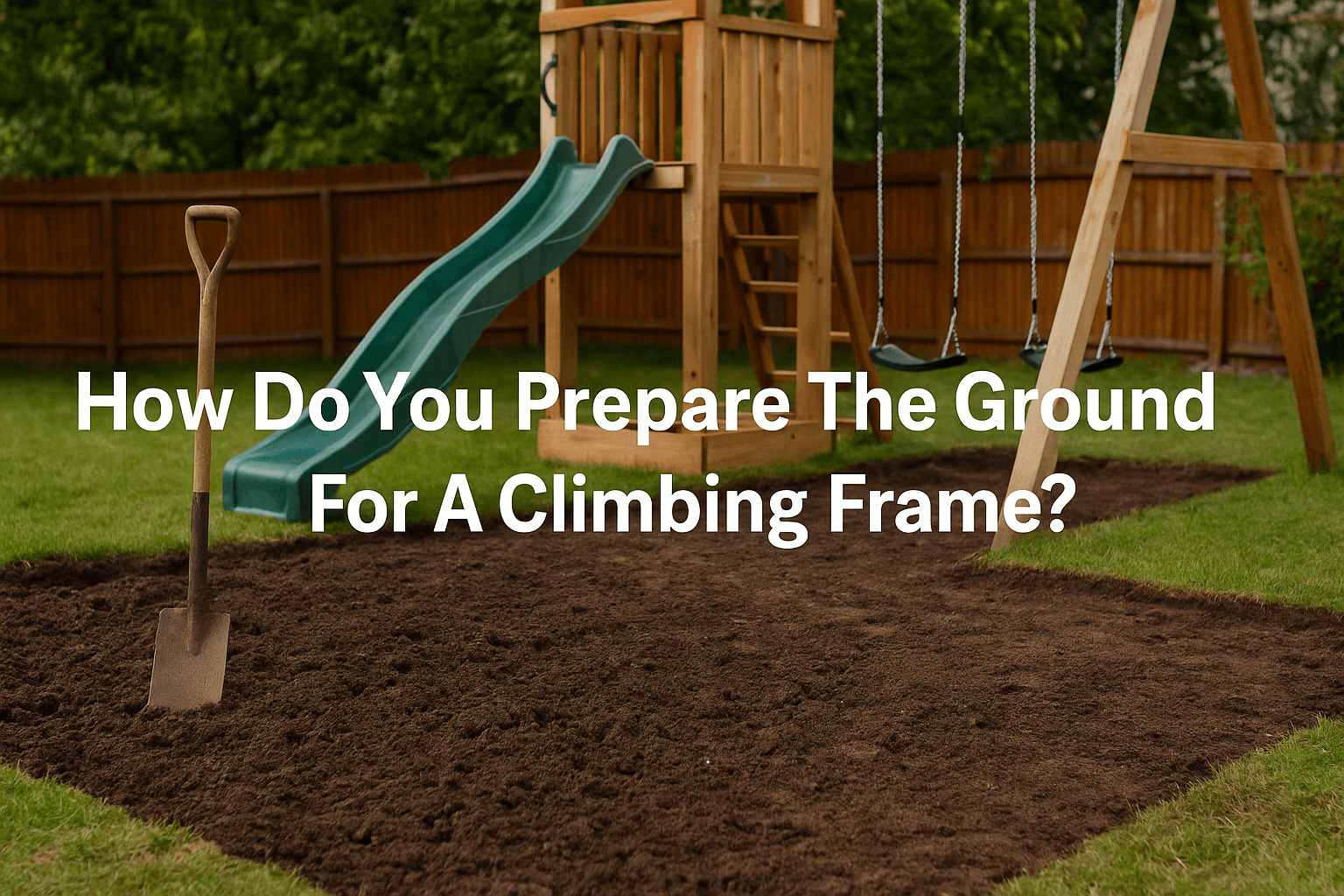
How Do You Prepare The Ground For A Climbing Frame?
Ever tried pitching a tent on a slope? That’s your play frame without proper prep. Short answer: Clear, level, drain, then add safety surfacing. It’s not glamorous, but it is essential. Want fewer scrapes, more giggles, and a frame that doesn’t wobble like jelly? Stick around—we’ll show you how.
Essential Ground Preparation for Climbing Frames
Why Proper Ground Preparation Matters
Ensuring Safety and Stability (level surface, prevents tipping)
Let’s be honest—kids play hard. They climb, swing, jump, and tumble. And if your climbing frame isn’t on solid, level ground, it’s only a matter of time before something tips over.
A flat, stable surface keeps things upright and steady. It also helps safety surfacing like rubber mulch or bark chippings do their job properly when a little one takes a tumble.
Extending the Lifespan of the Frame (drainage, preventing rot)
Think of your climbing frame like a house—it needs a solid foundation. If the ground stays soggy or uneven, you're asking for trouble. Water can cause wood to rot, metal to rust, and frames to shift.
By sorting out the drainage early and getting that ground level, you’re giving your play frame a much longer life. And let’s face it—less maintenance sounds pretty good.
Meeting Play Area Safety Standards (fall zones)
Accidents happen—especially when little legs are involved. That’s why safety zones matter.
Prepping your ground the right way means you’ve got enough cushioned space around the frame to soften any falls. It’s not just smart parenting—it’s meeting proper safety guidelines too.

Assessing Your Site
Checking for Levelness and Drainage
First things first—have a good look at your garden. Does water pool in certain spots after rain? Is the ground even, or is it on a slope?
You want a flat, well-drained area. It keeps things safe and makes everything easier when you’re levelling, surfacing, or installing.
Identifying Obstacles (roots, rocks, utilities)
Now, take a walk around the spot you’ve got in mind. Look out for tree roots, hidden rocks, or old stumps poking through the grass.
Don’t forget what’s under the ground either. Contact your local utility providers to make sure you’re not digging into gas lines, electric cables or drainage pipes.
Step-by-Step Ground Preparation Process
Clearing and Levelling the Area
Removing Debris and Vegetation
Time to get your hands dirty. Start by clearing out grass, weeds, sticks, stones—anything that’s in the way.
A garden rake or lawn mower can help, but don’t be shy with a spade either. The cleaner the slate, the better the frame will sit.
Digging and Grading the Ground (shovels, rakes, spirit level)
Use a shovel to dig down slightly if needed and a rake to even things out. Whip out your spirit level to check how flat it really is.
This isn’t just about making it look neat. A wonky surface means a wobbly frame—and that’s no good for playtime.

Enhancing Drainage and Stability
Adding a Sub-Base (gravel, crushed stone)
Got a soggy lawn after rain? Then you need a sub-base. Lay down gravel or crushed stone where your frame will go.
It’ll help water drain away, stop the ground from turning into mush, and keep everything stable.
Compacting the Ground
Once your sub-base is in, give it a good compacting. You can hire a plate compactor or just stomp it down manually with a tamper.
Either way, the firmer the base, the sturdier the play frame.
Choosing and Installing Safety Surfacing
Options for Fall Absorption (rubber mulch, wood chips, sand)
Now for the fun bit—picking your optional safety surface. Here are some popular choices:
-
Rubber mulch: Bouncy, long-lasting, and low maintenance.
-
Bark chippings: Affordable and natural-looking, but they’ll need topping up over time.
-
Sand: Classic and soft, though it has a habit of travelling.
Each one cushions falls differently, so think about how high the frame is and how much maintenance you’re up for.
Defining the Critical Fall Height
This sounds technical—but it’s simple. Every climbing frame has a maximum fall height, and your surfacing needs to match it.
The higher the play equipment, the thicker the safety layer. It’s what keeps those tumbles from turning into tears.
Final Checks and Considerations
Before Installation
Double-Checking Levelness and Drainage
Before anything gets built, double-check your work. Is the surface level in all directions? Pour a bit of water and see where it runs—if it puddles, fix it.
Better to catch these things now than after the play frame is in place.
Ensuring Adequate Fall Zones Around the Frame
Your climbing frame needs breathing space. Make sure you’ve left at least 1.8m (or 6 feet) on all sides for a proper fall zone.
It’s not just about space—it’s about safe landings.

Long-Term Maintenance of the Ground Area
Replenishing Safety Surfacing
Over time, your surfacing will settle. Bark compresses, sand scatters, rubber mulch shifts.
Make a habit of checking it now and then, and top it up when needed. It’s a small job that makes a big safety difference.
Managing Weeds and Water
Nature always tries to creep back in. Lay a weed membrane under your safety surfacing if you haven’t already.
And after heavy rain? Just keep an eye out for standing water or erosion, especially in winter months.
Creating a Safe Haven for Your Children to Play
Getting the ground ready for your climbing frame might not be glamorous—but it’s one of the most important steps.
From clearing the site to compacting the base, every stage helps create a safe, sturdy, and long-lasting space for your kids to enjoy.
So take your time, follow each step, and trust the process. Because once it’s all in place, and the kids are climbing, laughing, and burning off energy—you’ll know it was worth every shovel of dirt.
Have you checked out our other posts?
How Long Do Wooden Climbing Frames Last?
How To Build A Climbing Frame?
Do You Need To Anchor A Climbing Frame?
How To Secure A Swing On Grass?
How To Level A Climbing Frame?



Leave a comment